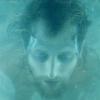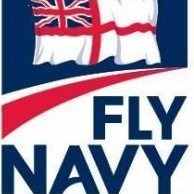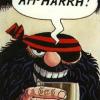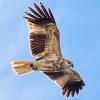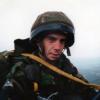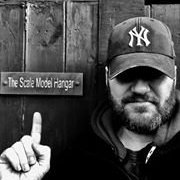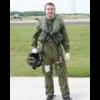Search the Community
Showing results for tags 'fleet air arm'.
-
Hi Guys, I've been coming here on and off for a while now with various technical questions for projects, so I thought it was about time I put my money where my mouth is and actually post something. This is the first scale model I've made about 15 years, and last time I tried something I had no idea of techniques and no money to buy proper colours, air brushes etc. So with that in mind, please go easy as I'm both a beginner and out of practise! This is the Airfix Seafire L.III, straight out of the box with Eduard etched brass cockpit details. I've done nothing else, other than my first attempt at scribing as the fuselage is an old mould and a friend of mine said I should! I went very easy on weathering as I know this is easy to get carried away with, but I've subsequently increased the dirt and stains on the underside of the aircraft. If any other beginners are considering this model, I'd probably recommend to look elsewhere. I've got a couple of years experience with wargaming - some of the skills are transferable, some are not - but things like attaching the arrestor hook were a huge job because the parts simply did not match up once the lower fuselage was cut away on the guidelines, resulting in a lot of man-hours being spent with modelling clay and filing.
- 10 replies
-
- 21
-

-

-
- Fleet Air Arm
- Seafire
-
(and 1 more)
Tagged with:
-
Interesting Pathe footage of Seafire XVs and Fireflies operating from HMS Theseus off the Australian coast, 1947 http://www.britishpathe.com/video/fleet-air-arm-off-australia Excellent footage of an era seldom seen, note the interesting paint scheme of the Seafire landing at 01:04, looks to be silver with dark nose trim? The title, 'Hazards and Thrills with Fleet Air Arm' seems a bit playful given the risks of deck operations!
-
Looking for help please from anyone with current RN Jungly Merlin knowledge. The recent "welcome back" photos from Yeovilton show a mix of HC3s and HC3As in RN markings, but I can't find any definitive info as to whether any of these aircraft (or only some of them) have already been modified to the interim naval standard or not, and whether the interim mods will be (or have been) applied to the HC.3A as well as the HC.3. As I understand it, an initial batch of ex-RAF aircraft underwent a basic mod package to add manual folding, rapid roping points plus better Nav & comms equipment and thus allow them to be stowed in OCEAN's hangar. I don't believe this includes tail folding. I think these are then designated HC.3i. I then believe the entire ex-RAF fleet (bar the one lost in Afghanistan and the one retained by Boscombe Down) including the 3As will be cycled through an extensive update over the next 5 years to HC.4 (and HC.4A) standards, to include the common glass cockpit, the folding tail, power blade fold and other naval modifications including changes to the HC.3A's winch (or has this already been done?). Going back to the current aircraft then: Does anyone know whether the HC.3As now in RN service with 845/846 Sqns (those with the ugly nose and lots of windows) have been modified to have a manual rotor fold (and does this make them "HC.3Ai"s). Does anyone have a picture of any HC.3 folded - do they sit the same as an automatically folding set? Is ther ea frame and handling arms? Does the blade root fairing change? Do you remove it manually before a fold? Does anyone know when this mod happened; would it have been applied to the 845 Sqn aircraft used in the Mojave desert in 2015 for Ex-Black Alligator? I would prefer to fold the HC.3A model currently on the bench, but have no idea if this is correct! FredT
-
Supermarine Seafire Mk.III Special Hobby 1:48 Our friends at Special Hobby have sent us two boxings of their Supermarine Seafire Mk.III Kit. The first is for those used by the Irish Air Corps and The Aéronavale. The second is for The Fleet Air Arm and is boxed for the 70th Anniversary of D-Day. It is believed that the Admiralty first showed an interest in a carrier based Spitfire as early as 1938, when Fairey Aviation proposed such a modification could take place. This idea was rejected and subsequently left the Fleet Air Arm to order other less capable aircraft. The matter was again raised in 1939 and a Spitfire was fitted with an A Frame arrestor hook. After further investigation folding wings were added to the specification. At the time one of the major factors holding back a Sea Spitfire (or Seafire as it was to become) was that production capacity was needed for land Spitfires. Due to this Wildcats were ordered from Grumman for the FAA to be called the Martlet. By the end of 1941 the Admiralty again looked at Spitfire project. 48 Spitfire Mk Vbs were converted by Air Training Services at Hamble to become hooked Spitfires. These would allow the Royal Navy to get experience operating the type, which due to its narrow undercarriage and high nose was not the ideal carrier aircraft. The second major type for the RN was the Seafire Mk II, this used a cropped supercharger to provide greater power at lower levels. The IIc was the first major mark to be deployed in any number. The Seafire Mk III was the real first true carrier Seafire. It was developed from the IIc. It had manually folding wings allowing more aircraft to be carried. The wing would fold using a system of two straight chordwise folds. A break was introduced immediately outboard of the wheel well where the wing would fold upwards and slightly forward, a second fold would be at the wingtip. The Mk III would use the Merlin 55 engine with a 4 bladed prop. The Mk III would be used by the Fleet Air Arm, The Irish Air Corps, and the French Aéronavale. The French would receive 65 Mk IIIs which were deployed to Vietnam on board the carrier Arromanches in 1948. The Irish Air Corps were supplied with 12 Mk III in 1947 which were stripped of their Naval equipment (except the wing fold) by Supermarine. The Kit The kit arrives in a fairly sturdy box. Inside are three large and three small sprues of grey plastic, a clear sprue, a sheet of vinyl, a sheet of photo etch; and an instrument panel film. Construction as with most aircraft starts with the cockpit area. The bulkhead forward of the pilot is made up along with the instrument panel. This is added to the engine firewall, the floor area including rudder pedals and control column is added. The seat can then be attached to its backing of armour plate, this along with the headrest is then added to the rear fuselage frame. PE seat belts and harness straps are then added. The next step is to add both of the previous subassemblies onto the main fuselage. Lage side panels with relief details are also added at this stage. The fuselage can then be closed up. The vinyl parts can then be applied to the closed up fuselage. The next stage in construction is the wings. The upper wing halves are attached to the one part lower wing. The internal sections of the wheel wells need to be placed inside the wing sections before they are closed up. The right cannon bulges need to be glued to the upper wing. There is no internal structure under the bulges. Be sure to use the right cannon bulges as there are four different sets on the sprues. The propellor is the next sub assembly to be built up, along with the arrestor hook parts If your build needs them). The next major task is to attach fuselage to the wings. Following this the tail planes, rudder, ailerons; and wing tips are added. Attention then turns to the underside of the aircraft. The radiators, engine under cowling, air intake and tail wheel are added. If your aircraft has an arrestor hook this sub assembly is also added, if not then a plate is added to this area. The undercarriage is also assembled and added at this stage. Finally to wrap up your build the engine exhausts, appropriate cannon barrels, aerial mast, entry door, propellor assembly; and canopies are added to the kit. Photo Etch & Vinyl A small photo etched fret is provided for the seat belts & harness, Instrument panel, rudder pedals, escape crowbar, and fuselage stiffening plates. A self adhesive vinyl sheet provides for raised areas on the fuselage where even PE would be too thick. An acetate film is provided for use between the PE instrument panel parts. Canopy The clear parts are very clear and remarkably thin. Care will need to be taken removing them from the sprue. I am not sure if the main canopy will fit over the rear part as the instructions do not show this. Decals - Aéronavale & Irish Air Corps Decals are provided for two aircraft as used by the The Aéronavale. I.F.12 Flottile 1.F The Aéronavale, Aircraft Carrier Arromanches 1948. FAA Camo, French roundels and a replacement rudder. 54.S.14 (exPR146) Flottile 1.F The Aéronavale, Aircraft Carrier Arromanches 1947. Older airscoops and longer cannon barrels were fitted. This aircraft retained its post war FAA paint scheme and markings. French unit markings were added to the fin. Markings are also supplied to make any one of four Seafires as used by The Irish Air Corps based in Gormanston 1947. Decals - D-Day Fleet Eyes Decals are supplied for two FAA Seafires with Invasion Stripes (The modeller has to paint these) NF541 886 Naval Air Squadron, No3 Air Spotting Wing, RNAS Lee-On-Solent 1944. Full invasion stripes were painted as the aircraft spotted for Naval Gunfire. On 8/6/44 this aircraft flown by Sqn L Chapman shot down a Bf 109. The aircraft was painted in the RAF Daylight Fighter Scheme. The instructions indicate the tail parts were replaced and left in a base green colour (Primer?). This aircraft had clipped wingtips. NF547 885 Naval Air Squadron, No3 Air Spotting Wing, RNAS Lee-On-Solent 1944. Full invasion stripes were painted as the aircraft spotted for Naval Gunfire, in particular HMS Warpite. On 7/6/44 the aircraft was shot down by AA fire and crashed in France. Lt Hugh Land (RNZNVR) managed to destroy the aircraft and evade getting back to Allied lines on 18/6/44. All decals are printed by Aviprint, are in register and colour density looks good. Conclusion From MPM kits I have bought in the past the plastic parts in this kit do seem to have improved. They are well moulded with fine engraved panel lines. There is a tiny amount a flash on some parts but certainly nothing the modeller can not remove. Its good to see this kit available in different boxing with just more than FAA markings. Overall I would highly recommend this kit. "Aéronavale & Irish Air Corps" Boxing "D-Day Fleet Eyes Boxing" Boxing Review sample courtesy of
- 5 replies
-
- 2
-

-
- Special Hobby
- Seafire
-
(and 3 more)
Tagged with:
-
'...and every where the blue sky belongs to them' Samuel Taylor Coleridge, Gloss to the Rime of the Ancient Mariner. 'Invert the aircraft, release harnesses and fall out' Emergency handling procedure from Sea Venom Pilot's Notes. Hello again all, The madness is upon me again! It's been a while since I posted anything visual, largely as I've had no real bench time at all of late, but after faffing around I've decided to do a sequence of related builds for the next year or so of various Fleet Air Arm aircraft from the 50s and 60s. Some classic jets and choppers from that era, that a recent visit to Yeovilton has rekindled my affection for. Here's some bench shots of the Frog 1:72 Sea Venom FAW.21 that will be the first in the series. Let's start with the good news: the decals seems usable and in good condition. Aaaaaaaand that's it for the good news... This splendid-looking aircraft has been subject of a number of builds already on BM, and whilst I love these older kits like Frog, can you see all that blasted flash? It looks more like a Frank Auerbach painting of a kit with all that baroque plasticity. Have a closer look and you'll see what I mean: As to the glazing I'm thinking this was originally intended as an insect eye rather than a canopy. Have I been given part of the old Airfix Praying Mantis kit in error? Pity the poor crew of this thing though; the moulding guys really went for a lovely 'Facehugger from Alien' approach - I'll have to call this crate 'Nostromo' now: Seriously. Did this kit partially melt in the post on the way over due to the recent heatwave or something??? Actually, I have my suspicions that as this was bought unboxed (and hence dirt cheap), it may not be an original Frog moulding as advertised but a later iteration - was the original mould of this kit ever this flashy BITD? S-oo..after having foresworn kits that need lots of correction (after my previous Dark Night of the Matchbox Meteor Night Fighter) here I am back with another kit needing as much attention probably. Of course I'm moaning too much. It's my own fault for buying it and I could always throw it away and buy a decent version. But you know I won't. I've got etch. 1/72 etch.... That will make it all better, won't it? I've some yet to do on colour and airframe details, but the notion at this stage is to to just go the whole hog, wingfolds and all, and see how we get on. BTW I noticed that Falcon do a really nice FAA vacform canopy set that included most of the aircraft I hope to do in this series, as well as that snazzy Model Alliance decal set for the Ark Royal air wing that also covers many of them, so I may have to break my embargo on any more purchases this month. bank manager... It's going to be a busy summer work-wise; I'll have to grab time at the bench as and when I can get it so my updates may not be as regular as I would hope. The main thing is that I hope you get to enjoy the journey and please pitch in as often as you want with any criticism and advice of my attempts to subdue this monster Tony
- 592 replies
-
- 9
-

-
- de Havilland
- Sea Venom
-
(and 6 more)
Tagged with:
-
The aircraft in which 'Winkle' Brown made the first landing of a pure jet aircraft aboard a carrier.
- 1 reply
-
- early jets
- naval aviation
-
(and 1 more)
Tagged with:
-
Something of a walkaround of the FAAM's example
-
- 1
-

-
- postwar jets
- naval aviation
-
(and 1 more)
Tagged with:
-
From my reference material, this is my understanding ... France and Belgium ordered an export version of the F4F-3, designated by Grumman as G-36A, powered (because of an export embargo on the P&W engine?) by a Wright Cyclone with a single stage two speed supercharger. These were taken over by Britain when France (who had taken over Belgium's order) fell. It was to have six 7.5 millimetre Darne machine guns, with two in the nose cowling and two in each wings. The French had sought some refinements to the G-36 design: A reflector gunsight was fitted and some armour and fuel tank protection was installed. In British service, the aircraft were known as the “Martlet Mk I”. The few which had been built before France’s defeat, were retrofitted to RN standards, including switching out the French radio and throttle. The armament was also changed. The engine cowled guns were dropped and two .50cal (12.7mm) MG fitted in each wing, although the gun positions were uniquely different to that in the F4F3 and other two gun winged variants. The remainder would be completed to the RN's modified specification. Otherwise, these Martlets were similar to F4F-3Bs. However, I can't find an official reference to a F4F-3B variant. I know there's the F4F-3 and F4F-3A. Can someone enlighten me? Also, any idea why the F4F-4B “Martlet Mk IV” reverted to the Wright Cyclone engine? Was it an attempt to improve the performance of folding wing, six gun Wildcats, by using a lighter single row engine than the usual two row Pratt & Whitney Twin Wasp? If so, I gather it wasn't entirely successful In trying to improve performance further, Eastern reverted to four guns in their FM1 development of the six gun F4F-4 and then took it further by also using the Wright Cyclone engine in the FM2. Thank you in advance
-
Not normally a helicopter fan, but having lived in Gosport/Lee-On-Solent all my life and having been taken in to Daedalus in 1981 as a young lad to look around this airframe, this is THE Wessex I've always wanted to build. A familiar sight along the South Coast before the post Falklands drab green versions were introduced, 772 NAS (?) provided the flight here at Lee (& at Portland?) whereas 771 were based at Culdrose. Whilst my building efforts don't match some of the glorious Wessex's found on this site, I enjoyed the build, although a loose article check would find most of the control sticks, seatbelts & other v small pieces somewhere behind the instrument panel! Decals were a mix of kit, spares box & hand painted. Kit decal sheet has come in for much criticism (size issues), true, but even worse is their Wessex III release that has mis-spelt "ROYAL NAVY" as "R-O-Y-A-L A-I-R F-O-R-C-E". As part of my son's continued education, this section of the decal sheet will be removed and burnt less he get any ideas that the Junior Service ever flew such a beautiful machine! pictures a mix flash on & off........still a way to go before I get any good!
- 24 replies
-
- 26
-

-
- 772 NAS
- SAR Wessex
- (and 5 more)
-
This is the Tamiya 1/72nd scale Corsair with the wings clipped to represent a Fleet Air Arm machine. I used a Eduard etched zoom set for the cockpit. The paints are all Xtracylix, and the decals are by Techmod. Vought Corsair II. Set 72014. The Aircraft is from 1834 NAS HMS Victorious 1944. Thanks for looking, Joe
- 30 replies
-
- 50
-

-
Saw this online just now- some interesting FAA shots from a personal album. The last image of the crashing aircraft most dramatic but can't identify the type: http://www.dailymail.co.uk/news/article-3558030/Fascinating-photos-Royal-Navy-captain-served-World-Wars-sale.html
-
Britannia Royal Naval College Air Experience Flight - 1957 This one has been a lot more difficult than I expected or its size suggests, but it is finished at last and photographed on this bright and sunny Spring/Easter morning! It's the recent 1/72 Airfix kit, with a set of home compiled decals for one of the four ex-RAF-ex-Civil aircraft that the RN bought in 1956 for use as flying acquaint aircraft. This one lived at Dartmouth until it was written off on 16/8/1962 after a crash on take off from Anges in the Pays de la Loire (sounds like a nice flying jolly to France was being had by someone at the time - fortunately no casualties!) This is a very impressive little kit with some superb fine detail. Mine was the civil version, with bright red and silver scheme out the box; another issue has WW2 camouflage and yet another starter kit has bright yellow trainer colours. However, despite its generally excellent fit and well thought out layout, it is not the easiest of builds, mainly due to the fragility of some parts, especially the wing struts. The main issue is the extra supporting structure that keeps the interplane struts at the right angle as you assemble the kit. These are an excellent idea and Airfix intend that you cut them off after assembly. making them suitably thin to help you with this. However the struts themselves are also very thin and I know I am not the only one who has has issues removing the unwanted parts afterward. I broke three of the struts trying to shave the helping parts off before giving up. Nice idea Airfix, but one that may cause more heartache than help for many modellers. The other surprising issue is that Airfix have provided the anti-spin strakes as separate parts, requiring you to cut out the upper fuselage and insert the new ones. This is really quite a fiddly task and difficult to tidy up afterward. A much better idea would have been to provide both versions as inserts; the excellent level of fit of the rest of the kit suggests that this would have been entirely feasible and certainly a lot easier for the builder than cut and shut. Rigging is lycra thread and just about drove me nuts. I normally enjoy threading biplanes and this is a fairly simple one, but on this occasion it seems my superglue has passed its sell by date and wouldn't stick to anything except my fingers. Much cursing and chuntering later it was finished, but not as neatly as I had hoped. Recommended for those with patience and a light touch!! FredT
- 20 replies
-
- 46
-

-
- Airfix 1/72
- BRNC Dartmouth
-
(and 1 more)
Tagged with:
-
Hi Everyone, I might have missed the cut for the Tiger Moth Group Build, but I did finally finish this really nice little kit. Markings are for the Royal Australian Navy Naval Air Station at Nowra in the mid-1950's. Decals are from Southern Sky models and the kit is of course the new-ish Airfix 1/72. I had my usual bumps and scrapes in the build process but I enjoyed it very much, especially my first attempt at biplane rigging which was done with invisible thread and superglue. (I gave up attempting the elevator rigging!) For the photographically-minded, it was my first attempt at using the focus-stacking function on my Olympus m43 camera which composites several pictures with slightly different focus points in order to get more of the small model in focus. It worked very well. The last shot with the engine "running" is me blowing on the propeller whilst pressing the shutter! I couldn't use focus-stacking for that, rather a very narrow aperture which still doesn't get all the plane in sharp focus. Thanks for looking, Andrew
- 55 replies
-
- 61
-

-
In the 1950s the Royal Navy was looking for a fast low-level bomber, capable of delivering a free-fall nuclear weapon, for its Fleet Air Arm squadrons. Blackburn’s had traditionally been a supplier of naval/maritime aircraft since World War One (e.g. the Blackburn R.T.1 Kangaroo maritime patrol aircraft) and they jumped at the chance to build a fast, carrier-borne jet. The N.A 39 design which emerged from the design process was rather disappointing in some ways. The angle at which the aircraft was launched from the steam catapults on the British fleet carriers was critical at certain gross weights, and the 7,100 lb st de Havilland DGJ.1 Gyron Junior engines were both underpowered and ‘thirsty’. For these reasons, the Buccaneer S.1 got mixed reviews. Whilst all this was going on, the RAF had shown absolutely no interest in the Buccaneer. They were going to have the superb BAC TSR.2 (an aircraft so advanced that it would still be in service today as an ELINT or photographic platform). Unfortunately, the politics that killed the TSR.2 also killed the RAF’s American replacement for it, the General Dynamics F-111K. Suddenly, the RAF needed a fast bomber – fast – and there was the Buccaneer! The Royal Navy was retiring their fleet carriers, and the RAF ‘inherited’ their McDonell Phantom FG.1 (F4K) aircraft, as well as the ‘Buccs’. A new version of the Buccaneer, the S.2B, was developed specifically for the RAF, with the superb Rolls-Royce Spey 101 turbofan engine of 11,100 lb st (Speys were also in the Phantom FG.1) and this gave a massive boost to the Blackburn design. The RAF inherited an aircraft with very useful characteristics; a heavy-duty undercarriage (designed for carrier landings), folding wings (easy on hangar space), split speed brake in the tail, arrestor gear (useful for battlefield short-field ops.), and buddy-buddy refuelling capability. More importantly, the ‘Bucc’ could go places – in a hurry – like 540 knots at 100 feet a.g.l. or LESS! Its ride – on the deck – was nothing short of superb. I have seen film of a pair of Buccaneers ‘attacking’ a US-manned ‘threat site’, at 500 knots plus, in a Thatch weave, at below 100 feet. The site operators were unable to maintain lock on the incoming pair and just gave up! The first time the RAF sent Buccaneers to Exercise Red Flag in Nevada, the F-15 pilots and AWACS crews were gleeful at what they assumed were easy kills ahead. At the end of two weeks there were red faces at Red Flag – not one single ‘Bucc’ kill, and lots of targets eliminated. The Buccaneer’s last hurrah came with the 1991 Gulf War. A detachment was hastily refinished in ARTF (Alkali Removable Temporary Finish) Desert Pink and flown out to Bahrain. Providing laser targeting facilities (via their ‘Pave Spike’ pods) for the RAF’s Tornado GR.1 strike aircraft, they also joined in bombing raids, carrying their share of 1,000 lb TI Paveway II laser guided bombs. Sadly, the end came due to metal fatigue. Two aircraft (and their crews) were lost due to structural failures in flight, and many were found to have cracked main spars, at the end of a long and hard life. There were those who say that the Buccaneer should have been re-spared (not just repaired), ‘zero-timed’ and updated, but it was not to be. It was replaced by the Panavia Tornado GR.1 – which could not carry as much, or as far, or as fast at low level, and was just not as manoeuverable as a ‘Bucc’. The former Thunder City (South Africa) Buccaneers, which used to be available for display flying were forced to be sold when the company was wound up, following a fatal English Electric Lightning crash. You've just gotta love the 'Banana'!! For this GB I have an old Frog S2 kit (I know not the best but has the S2 flat belly), hoping to get some extras by way of a C Scale White metal set with slipper tanks etc (martels not in service I think?). I will use the Model alliance MA-72177 sheet to build an HS Buccaneer S.2 XN980/233 of 801 Naval Air Squadron, Royal Navy, operating from HMS Victorious in 1966. Sprue shots: Now I do have a 1/72 older RAF Airfix boxing, tempted to do an S2B as well....I also have an Airfix 1/48 boxing. again an S2B, to be done as per the Gulf War...tempted! Some great tips on modelling any Buccaneer and plenty of info: http://www.blackburn-buccaneer.co.uk/Pages3_files/Model_Directory_Index.html?
- 58 replies
-
- 13
-

-
Ok my second STGB for the year! I have been tossing around whether I was or wasn’t going to do a build for this one but the calendar is sort of free so why not! So for this one I’ll be building a Fleet Air Arm Corsair II JT 410 off the carrier HMS Victorious, this will go along nicely with the Avenger/Tarpon I that I did for the FFA GB. The base model will be the lovely 1/48th Tamiya F4U-1A. Plus a few extras thrown in, Eduard PE bits… …..UltraCast seat with the right seatbelts…though it does look a wee bit small! ….plus decals from EagleCal. Being a FAA Corsair there will be a couple of mods required, most notably I need to clip the wings. A simple task on the Tamiya model…luckily! Plus there are some other minor changes needed as well, and if I can’t be bothered to do them from scratch then I may get the MDC Corsair Mk. II & Mk. IV conversion kit. Hopefully I can make a start this weekend, whilst I’m waiting for bits to dry on the Thunderbolt.
- 69 replies
-
- 9
-

-
- Tamiya Corsair
- F4U-1A
-
(and 3 more)
Tagged with:
-
Hello all, this is my latest completion, Accurate Miniatures 1/48 Grumman Avenger. This kit is no shake and bake model, but with some effort it can be built without too many drama's. I chose to build a subject close to my heart: This Avenger is JZ670 "AHBX" of 707 Squadron Fleet Air Arm. She was an Avenger Mk.III and she can be seen in the photograph below during her time at HMS Ringtail in West Lancashire, England. In an attempt to bring my Avenger up to Fleet Air Arm Spec, I scratch built an observers position behind the pilots seat. This involved installing a seat, fold out table and instruments. I did the best I could, but I have no idea how accurate my efforts have been. On that note I would like to say thanks to the forum members here who went out of their way to give advice and share references. I used the Freightdog Models decal sheet "Brits at Sea-Part 1" for the 707 sqn markings and I mixed my own shade of Gloss Sea Blue from Tamiya acrylics. I like the colour, again it may not be "spot on" Here are some photo's of the finished model, I hope you like it! You can see more pics of this build and it's W.I.P. on my blog. http://thescalemodelhangar.blogspot.co.uk
- 36 replies
-
- 48
-

-
What If III Group Build. After the Torrey Canyon disaster in March 1967, the RAF and the Royal Navy came in for criticism as 25% of the 42 bombs dropped missed the target. The main reason being was, not the lack of skill by the Pilots but bomb technology was lagging behind aircraft technology. The Royal Navy was asked to form a ground attack squadron to help develop tactics with the new bombs being developed for the armed forces. The squadron was to be land based, but able to operate not only from Royal Navy Aircraft Carriers, but also U.S. Navy Carriers when required as some of the trials would be from U.S. Ships. The decision was taken to obtain Douglas A-1 Skyraiders from America. The American Navy was phasing the Skyraider out, and starting to receive the LTV A-7 Corsair II. Not only could the Skyraider operate from US Navy Ships, but the American maintainers knew these aircraft very well. Another advantage, was the fact that they would cost less to operate than front line jets such as the Buccaneer. They would be based at RNAS Culdrose (HMS Seahawk) in Cornwall. The Skyraider had been operated by the Royal Navy before with the AEW version of the aircraft, so had some experience of the type. This squadron would be operating for approximately 2 years during the trials period. The aircraft would be painted in Extra Dark Sea Grey and Sky, as were other Royal Navy propeller aircraft of the time. The responsibility was given to 700 NAS, which was, and still is to this day, an Intensive Flying Trials Unit (IFTU). Originally formed in January 1940 at RNAS Hatston (HMS Sparrowhawk) in Orkney. It was intended for the squadron to be formed in January 1968, to 1970 operating with the Suffix letter A. Thus being known as 700A NAS. At the same time, 700 squadron would also be carrying out IFTU duties with the introduction of the McDonnell Douglas F-4K Phantom II FG.1. This squadron would be known as 700P NAS . As the intention was for cross deck operations with the American Navy, a decision was made to paint colourful tail markings as was common with US Naval Aircraft at the time. On account of the squadrons connection with hawks (formed at HMS Sparrowhawk, and now stationed at HMS Seahawk), it was decided to incorporate a bird of prey in the tail art work. 700A operated sea trials on several Royal Navy ships including, HMS Ark Royal (R09) and HMS Eagle (R05). USS Forrestal (CV-59) was the first American ship 700A performed trials on while she was in the Mediterranean during 1968. As they were based in Cornwall, they became known as the Pirates of Penzance by the Americans. This led to a Pirates head being painted on the engine cowl of their aircraft. In September of 1969, the Skyraiders of 700A embarked on the USS Independence (CV-62) for a NATO exercise in the North Atlantic (NORLANT). During this exercise, the USS Independence participated in testing the Hawker Siddeley Harrier in flight deck operations. Incidently, 700A would form again in 1979 operating the new BAe Sea Harrier FRS1. The unit would paint the same tail markings on the tails of their Sea Harriers, that was painted on the Skyraiders embarked on the USS Independence during that exercise. After a very successful trials period, 700A was decommissioned in early 1970's. 700 NAS returned to RNAS Culdrose from 1998-2008 operating as 700M NAS with the Agusta Westland Merlin HM.1 and again in 2014, until the present day as 700X NAS testing the Boeing Insitu ScanEagle. Thank you for looking, Joe Click on Fleet Air Arm Mk.1 Skyraider for RFI link.
- 124 replies
-
- 6
-

-
- What If Group Build III
- Tamiya
- (and 5 more)
-
Hello Gentlemen, this will be my entry to the F4U Corsair STGB. Tamiya 1/72 scale Bird Cage Corsair The model sprues. Xtradecal Set X72140 Yanks with Roundels Part 1 The Decal Sheet. Eduard Zoom Set SS270 Thanks for looking, Joe
- 19 replies
-
- 6
-

-
- Tamiya
- 1/72nd scale
-
(and 4 more)
Tagged with:
-
Back in March 2002, Paul Lucas published a Seafire WWII camouflage article in Scale Aircraft Modelling, accompanied by some artwork to illustrate typical camouflage and markings. In June 2009, he re-visited the subject in Model Aircraft Monthly. One issue he looked into was the use of Day fighter Scheme (Dark Green, Ocean Grey and Medium Sea Grey) on some Seafires. The article’s conclusion (based on colour film evidence) was that some if not all Seafires appearing to have Dark Green and Ocean Grey upper camouflage, had Sky (as per the standard Temperate Sea Scheme)rather than DFS Medium Sea Grey. Tony O'Toole has looked at this at length. For Westlands, the adoption of the correct Temperate Sea Scheme and 4” presentation of the serial, seems to have started from the NN serial range, with airframes in the LR and NF serial ranges appearing to have Dark Green, Ocean Grey upper surface camouflage and 8” presentation of the serial, identifiable by the high contrast between the two colours and the darker tone running through the cockpit. A photo of Seafire IIIs on HMS Keldive, circa August/September 1944, is often referred to when looking to compare schemes in the same shot (the second aircraft on the left being in TSS and the others in DFS or the DFS/TSS hybrid scheme. Aircraft codes (K for the carrier plus the aircraft letter) are thought to be in Red. Compare it with the colour version. It immediately becomes clear that the codes are not red, indeed they appear to have been removed or weathered away. Why is this? The demarcation between the upper and lower surface camouflage on the nose also seems lower on TSS camouflaged Seafires.
-
Back in March 2002, Paul Lucas published a Seafire WWII camouflage article in Scale Aircraft Modelling, accompanied by some artwork to illustrate typical camouflage and markings. In June 2009, he re-visited the subject in Model Aircraft Monthly. In both articles, MKIIc MB244 6Q, the subject of a rare WWII colour photograph of 899 NAS Seafires on HMS Indomitable in June 1943 at Scapa Flow (evidence item 1 in the list below), was depicted with no Vokes filter. Another photo taken a minute or so later by the same photographer shows other airframes without Vokes filters present on the flight deck as MB244? goes down on the lift (evidence item 1 in the list below). 6K could be MB198 and 6L is MB200. I let it go the first time, but after the second time, I wrote in, pointing out the photographic evidence. My letter and a revised profile was duly published by the magazine in the August 2009 letters page. One of the photos I referred to as proof that there were MKIIcs with Vokes filters fitted, present at the time MB244 was photographed, was a photo of two pilots posing by the cockpit of a Seafire with said filter and squadron number 6. It also had a nice bit of artwork under the windscreen (evidence item 2 in the list below). A photograph of the same aircraft with a pilot climbing in to the cockpit, appeared in Modellers Datafile 3 Merlin Seafires (evidence item 3 in the list below). However the identity of this particular aircraft would remain a mystery until I happened to be looking at an article about Seafire development on the Armoured Aircraft Carriers web site and I looked at the imbedded Pate Newsreel 'Presenting Seafires 1943’ (evidence item 4 in the list below) which can be viewed on You Tube. Low and behold this footage showed a pilot getting into and out of the cockpit of the very same aircraft (clearly the same aircraft by position and artwork). The serial, squadron number and aircraft letter is shown to be MB195 6S as the pilot walks along the fuselage to climb up into and later, climbs out of the cockpit. Furthermore, another photo in an article about Indomitable on the Armoured Aircraft Carriers web site (evidence item 5 in the list below) shows MB195 on Indomitable’s lift confirming the serial and squadron code and extent of upper camouflage on side of the Vokes filter (can't show photo). I then noticed a further photograph of this particular aircraft in From the Cockpit Series No. 13 Seafire (evidence item 6 in the list below), which confirms the serial and code. Why 899NAS should have several airframes with Vokes filters (which would have incurred a weight and drag penalty) at Scapa Flow, is a mystery. I know the carrier and its squadrons were due to leave for the Mediterranean, but why modify some but not all airframes, if that was the intention? I wondered if those Indomitable Seafires seen with blue (as opposed to the normal TSS Sky) undernose panels were airframes which had had their Vokes filters removed in the field and replacement panels from RAF stocks used? Evidence list 1 Warpaint Series No. 72 Merlin Seafire – cover June 2009 Model Aircraft Monthly – between p36 and p37 Seafire book by David Brown – cover http://ecx.images-amazon.com/images/I/51rTf8q1LCL._SX382_BO1,204,203,200_.jpg Colour photo of MB244 –shows clearly the Vokes filter with camouflage running down the side of the filter. Another photo taken a minute or so later by the same photographer shows other airframes without Vokes filters present on the flight deck as MB244? goes down on the lift. https://c2.staticflickr.com/8/7669/16636868203_1a71c96c33_b.jpg 2 From the Cockpit Series No. 13 Seafire –p26 Also Seafire book by David Brown – photo 29 b/w Photograph MB195 - pilots posing by cockpit taken at the same time as the Pate News footage –shows a clear image of the artwork – looks like a black and white cat shagging a white mouse? 3 Modellers Datafile 3 Merlin Seafires – p37 b/w Photograph MB195 pilot climbing into cockpit, taken at the same time as the Pate News footage was being filmed or possibly a still taken from it 4 Pate News –‘ Presenting Seafires 1943’ https://www.youtube.com/watch?v=f-BuAkwB5hI&feature=player_embedded also Armoured Aircraft Carriers website on Seafire development http://www.armouredcarriers.com/seafire-development - b/w footage MB195 between 7-13 seconds and between 44-51 seconds Pilot getting into and out of cockpit. Serial, squadron number and aircraft letter shown as pilot walks up to climb up into and later, climb out of the cockpit. None of the Seafires seen taking off and doing flybys have Vokes filters fitted. 5 Armoured Aircraft Carriers website Indomitable page http://www.armouredcarriers.com/lessons-learned http://static1.squarespace.com/static/531fdb48e4b0e8fbe6259952/53793c57e4b003ad465809df/5468292be4b0680da8b33094 b/w Photograph MB195 starboard side profile on lift confirms Serial and squadron number and extent of upper camouflage on side of Vokes filter. 6 From the Cockpit Series No. 13 Seafire –p24/25 b/w Photograph MB195 being pushed forward- confirms Serial and aircraft identifier letter
-
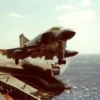
Phantom F-4K No.2. XT596 Royal Navy / A&AEE
At Sea posted a topic in Ready for Inspection - Aircraft
I bought from ebay a part started Phantom FG.1 with no decals and a missing canopy. So I went looking for some decals to complete it with and came across the RAM Models set, however this still left me needing stencils, so I figured a bit of artistic licence, build a very early FG.1 and use an F-4 B/N set, this would at least be in period, my thinking was the YF-4K's were painted and finished with the stencils McDonnell had available until the British specific ones were made. Sounds likely to me anyhow! The RAM models set is not cheap but they went down extremely well, nicely coloured and in register. As a nice bonus I swapped one version (700P NASU) decal set for a canopy. :-D Kit, Hasegawa 1/48 Phantom FG.1, Decals Ram Models early Phantoms, stencils KitsWorld F-4 B/C/D/N. Paints, Humbrol EDSG Enamel, Halfords white primer and all the rest by Tamiya. Built OOB apart from decals. Enjoy.- 24 replies
-
- 11
-

-
Hello! This is my Airfix 1/48 Seafire F.XVII built with a few minor tweaks. I haven't been building for a while due to lack of spare time but things are better now and I wanted to get back into things with a quick 'n easy build. So nothing special, just a simple clean almost OOB model. More details can be found on my blog, for now I'll shut up and post some pics. Feel free to let me know what you think, good or bad.
- 46 replies
-
- 48
-

-
This will be my build for the KUTA VIII Group Build. I first started building this seven years ago! I was making it for my Son's friend who was at the time, a serving member of the Fleet Air Arm. Since then, he has done his 22 years and left the Royal Navy. I feel this man has waited long enough for his model. So I intend to get my bottom in gear and try my hardest to finish it in the given time span. This will be my third group build. I finished the other two in time, so I think this will keep me motivated to finish this one as well. The photo shows how far I've got. The fuselage is just taped together with the other required parts bagged up. The first job will be to get the interior finished so I can glue the fuselage together. There are a few other bits and pieces that I can still attach before doing that, which I will do if it helps progress the build. The last helicopter I made was the Matchbox Chinook. That was a few years ago. I made it for a model airfield layout that I made for my Son. (I've just looked on line, and that kit was released in 1986!). So helicopters are not my strong point, but I'll make the best job I can of it. Thanks for looking, Joe.
- 11 replies
-
- 1
-

-
- Revell
- 1/72nd scale
-
(and 4 more)
Tagged with:
-
Morning all! It's only taken approximately three years to get to this stage, but my Dynavector Wyvern is finally finished. This was my first venture into the world of Vacform kits, and Dynavector did not disappoint. I chose this as by all accounts it is one of the best kits to use as an introduction to vac kits. The fit of the parts is absolutely superb, and once the necessary surface prep was done in order to get parts to match up, this went together with far less hassle than a lot of the injection moulded kits I've built. My build is by no means perfect, in terms of improvements I could've removed the aircraft lights and replaced them with appropriately coloured clear plastic. I deliberately chose not to overly detail the undercarriage bays as this build was more about testing my ability to build a vacform not my ability to superdetail. I've also missed off the windscreen wiper as my attempt to scratchbuild one looked a bit too 'agricultural' for my liking, so some room for improvement there certainly. Lastly the decals from Berna were a bit of a nightmare, many of them are grossly oversized and they refused to conform to the model without masses of Mr Hobby Setter and Softer. In terms of lessons learned from the build, first and foremost is that Vacform kits are not hard! Picking a good brand such as Dynavector or Aeroclub helps no end, but they are no more difficult than many injection kits (stand fast Tamiya shake and bake kits...) so really ought to hold no fear for anyone! After all if I can manage it, I'm certain anyone can! As always, constructive criticism is more than welcome, without it I'll never improve. So without too much further ado... Kit: Dynavector 1/48 Westland Wyvern Decals: Berna Decals - Wyverns Extras: Compass Rose Resin - Cockpit Tub + Airscale Instrument Decals, CMK Wyvern wheels & Pavla Martin Baker Mk.2 Seat Paints: Xtracolor EDSG & Sky, Humbrol Roundel Red and various shades of Alclad (undercarriage and undercarriage bays) To all those that looked in on the build (as glacial as it was in terms of progress) thank you for all the words of encouragement! Now it's just a case of deciding what to tackle next... Scimitar? Swift? Thanks for looking in folks, Regards, Nik
- 29 replies
-
- 34
-

-
- Vacform
- Dynavector
-
(and 5 more)
Tagged with:
-
Airfix's superb 1/48 Seafire 17, one of my older builds which i thought i'd share as i haven't finished anything lately. This is a shake and bake kit that went together very easily, and was a relaxing build. Loads of options available OOB - wing fold, ordenance, positional flaps. It all there without aftermarket, save seatbelts. Hope you like!
- 26 replies
-
- 23
-



